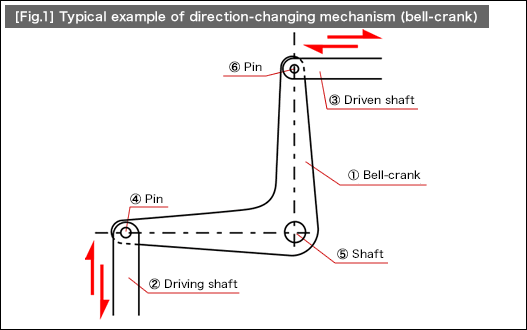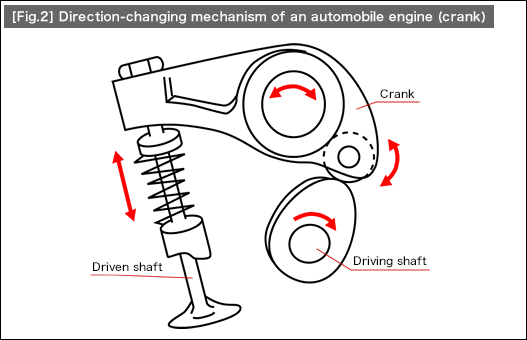#260 Basic Elements of Automation Clever Mechanisms: Direction-Changing Mechanism -1
The direction-changing mechanism is a mechanical component that alleviates restrictions such as arrangement or size on the mechanism design when transmitting forces from the driving shaft to the driven shaft. In other words, this mechanism changes the direction of forces or motion from the driving shaft without transmitting them as they are. In the next two volumes, we will study the typical examples of a direction-changing mechanism.
(1)Direction-changing mechanism using bell-crank
[Fig.1] is an example of the direction of motion changing between two links on the same plane of a 90-degree bell-crank.

The bell-crank shown here is a component consisting of two links connected at a certain angle on the same plane. In [Fig.1], the vertical reciprocating motion of the driving shaft (2) is transformed into the horizontal reciprocating motion of the driven shaft (3).
[Fig.2] illustrates the direction-changing mechanism (crank) adopted for automobile engine parts.

= Cautions on designing direction-changing mechanism using links and a bell-crank =
In the case of [Fig.1], forces from the driving shaft will be transmitted through the pin (4) to the bell-crank. The forces rotate around the shaft (5) and travel to the driven shaft (3) through the pin (6). When designing this structure, the following two points must be kept in mind:
| a) | Select appropriate fit dimensions for pin diameter/hole and shaft diameter/hole for smooth movement | |
| b) | Adopt abrasion-resistance measures |
The table here shows a dimensional relationship among pin diameter, shaft diameter, and the corresponding hole for the three types of motion statuses. All dimensions are based on the "clearance fit".
|
For how to select fit dimensions, details will be introduced in another volume.
In the next volume, we will learn about the direction-changing mechanism using springs.
- Positioning technology
- Designing and processing
- Sensor Technology
- Automation elements technology
- Clean room technology
- Design hints
- Design tips
- Designing and Machining
- Drive mechanism design
- Hints on designing
- Linear Motion Components
- Locating Technology
- Manufacturing technology
- Motion mechanism design
- Pneumatic Drives
- Production Technology
- Technology Outlook
- General description
- Low-cost automation and materials
- Transfer LCA
- #333 Know-how on automation: Pressurized heating technology - 5: Multilayer pressurized heating process technique
- #332 Know-how on automation: Pressurized heating technology - 4: Points to remember when designing mechanism of pneumatic pressurization method
- #331 Know-how on automation: Pressurized heating technology - 3: Pneumatic pressurization method and pressure profile
- #330 Know-how on automation: Pressurized heating technology - 2: Pressurization method and pressure profile
- #329 Know-how on automation: Pressurized heating technology



